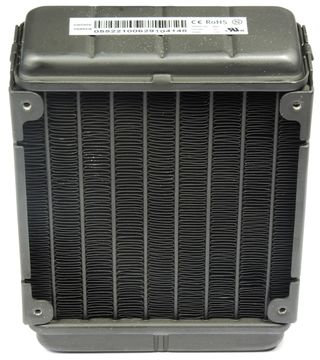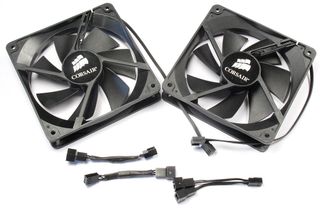Corsair H70: Next-Gen Self-Contained Liquid Cooling
Liquid cooling still has the image of being expensive and complicated. Corsair, in cooperation with the cooling specialists at Asetek, now offers the H70 that aims to simplify the step up from air cooling. Can it beat less expensive premium heatsinks?
Mounting The Radiator And Fan
Compact Radiator With Lots of Fine Fins

At a height of about 15 cm and a width of about 12 cm, you can easily install the radiator inside large-enough cases by attaching it to a 120 mm fan ventilation hole. The depth of the radiator is 5 cm--twice as thick as on the Corsair H50 model. If you use both of the included fans by sandwiching the radiator in a push/pull configuration, you get a total thickness of 10 cm, which could become a problem in more compact cases.
The radiator's fins are quite dense, spaced just 1 mm apart. On the one hand, this provides for a high number of fins, creating a large surface area for heat transfer. On the other hand, this also restricts air flow, so you should definitely use both fans in order for the radiator to work at maximum effectiveness.
As mentioned before, these fans rotate at 2000 RPM, but can be slowed down to 1600 RPM with the included resistor cables. This is necessary if you are aiming for a relatively low-noise kind of setup. The fans have rather short cables, at just 21 cm each. Depending on where in your computer case you install the radiator and where on your motherboard the fan connectors are placed, this might pose a problem.
Installation

Installing this liquid cooling system is fairly easy, although you might need to think things through when fastening the water block to the motherboard. You need to use the appropriate mounting hardware that fits your motherboard. Installation instructions are included to help you choose the right one. For our LGA 775 system, we first had to attach four risers on the water block back plate that goes on the rear side of the motherboard, which the screws are fit into later.
You also need to fasten a plastic mounting bracket on the front of the motherboard, and you should take a close look at the instructions so you do not choose the wrong one, as the included mounting bracket fastening parts are confusingly similar.
Stay on the Cutting Edge
Join the experts who read Tom's Hardware for the inside track on enthusiast PC tech news — and have for over 25 years. We'll send breaking news and in-depth reviews of CPUs, GPUs, AI, maker hardware and more straight to your inbox.
When the preparations are complete, everything goes quickly. Attach the back plate to the motherboard, then the mounting bracket, and finally put the water block on top of the CPU. With a twist to the right, the water block is securely fastened to the mounting bracket. The final step is to tighten the screws, preferably in a diagonal order so that you do not put too much stress on just one side of the CPU and socket.
Fan Configuration

The radiator can be installed pretty much wherever you want it--within the boundaries set by the length of the tubes, of course. A good choice seems to be in the back of the computer case.
The two fans included provide for a couple of different configuration options. Corsair recommends attaching them both to the radiator in order to achieve maximum cooling performance, but you also have to decide whether you want to have them suck in cool air from outside the case through the radiator, or blow out hot air from inside the case through the radiator. Here you have to take into account maximum CPU cooling versus the risk of heat accumulating inside the case and making the rest of your components warmer. You probably need to play around a bit with this to see what fits your case and fan setup the best.
Also, remember to balance the number of fans sucking air in and fans blowing air out, as axial fans of the kind used in computer cases are less effective when working against large differences in air pressure.
Current page: Mounting The Radiator And Fan
Prev Page Corsair H70: Design And Technical Data Next Page Test Configuration And Cooling Performance-
wribbs "street price of around $110, it is reasonably priced" -too high.Reply
"slightly elevated background noise" -understatement
You will be better served by the h50, yes its weaker but its cheaper and quieter and performs close to the same. Do yourself a favor and avoid this product although it is quite good.
-
karma831 Overpriced, equal to or gets beat by air cooling in temps, and is pretty loud...Doesn't sound like a very good product ?__?Reply
The prolimatech and noctua offerings are much better. -
maxal Would it be possible to post combined charts of idle temp/noise and full load temp/noise ? IMHO that would be more informative than plain bars, as many are interested in balance of those characteristics.Reply
-
gkay09 I had expected to see even the CM Hyper 212+ results...Reply
IMO $110 for such a cooler not worth it,...Other good option if going for a closed loop cooler would be the CoolIT SYSTEMS ECO... -
cmcghee358 I would have also liked to have seen comparison between a push/pull exhaust, and a push/pull intake.Reply
For my H50, it is quite explicit that the radiator should be pulling outside air through the fins. And yet, people keep it as an exhaust and then lament of their temps.
One of the biggest perks of a closed loop water cooling system is you dictate what air is being used. Where-as big air is always restricted to case air(unless a side is removed and a box fan is added)
I would have also liked to of seen it as a delta above ambient, rather than a flat CPU temperature comparison. I personally process the delta better, and lend more credence to it. -
uruquiora would have liked to see the temps in passive mode, with no fans, and on a more recent CPU...Reply -
mjello I want one for my gfx card not the cpu. Its my gfx thats noisy. I don't care about cooling temps or overclocking as long as the cooling is adequate. I just want sweet silence :).Reply -
cmcghee358 Reply9503478 said:I want one for my gfx card not the cpu. Its my gfx thats noisy. I don't care about cooling temps or overclocking as long as the cooling is adequate. I just want sweet silence :).
I guess you missed the part where it was the noisiest thing on the list with a 57.3 dB at max?
Also considering the TDP of some of these GPUs are between 190 and 300W, you can expect the H70 to work much harder thant he sample 130W CPU. So it will most likely be loud all the time because of the higher operating temps of the GPU.
Most Popular


